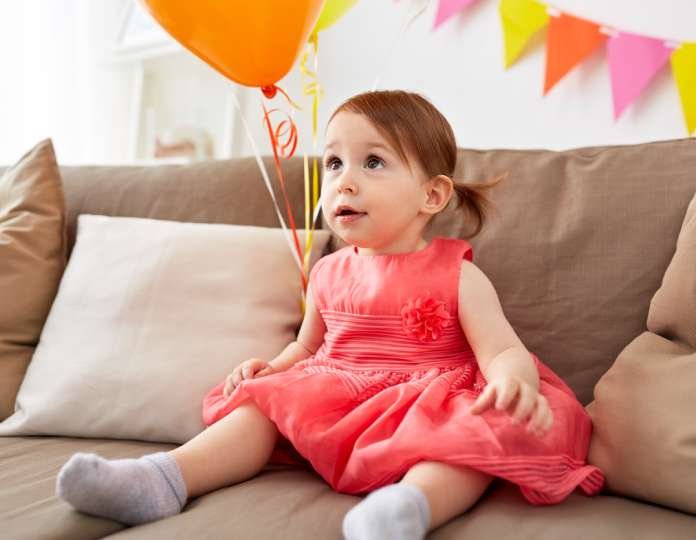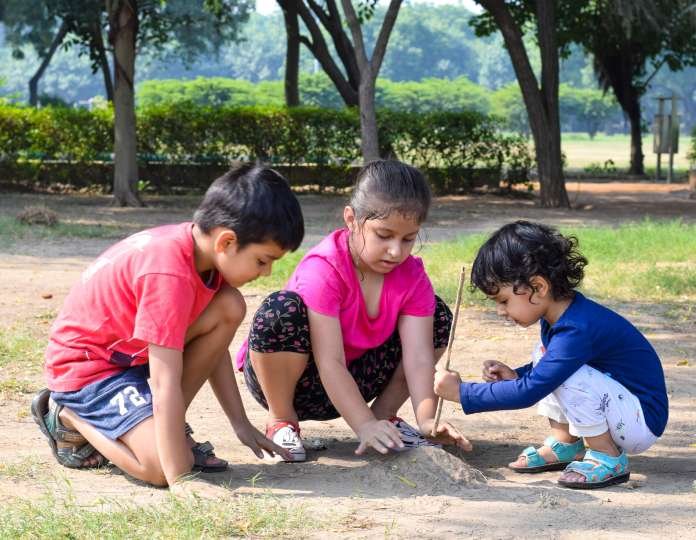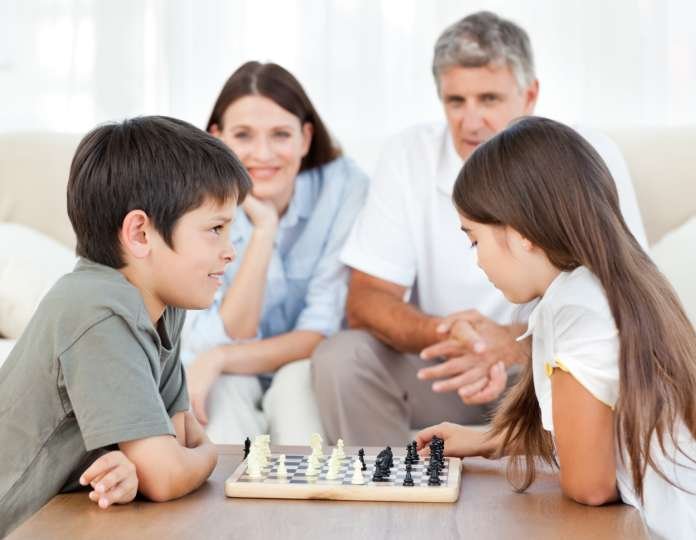A toy carousel hung above a 4 month old baby and the baby looking at its movement as it moved around, sand buckets, shovels, in the sand pit area, amma’s small cooker, her ladle, her rolling pin all in the living room, a scale and a roll up board and some chalk, bicycles, badminton rackets, snooker cue sticks – a stage set for play.
Play – is such a simple word, a simple process, and a very enjoyable time in a child’s life. If extended to adulthood, it has the same importance, value, and relevance as seen during a child’s life. Most often play does not seem to generate an image of structure and seems a very natural thing to engage in, something that does not seem to be restrictive, but free.
As stated by Bettelheim. B an Austrian psychologist, it refers to any set of activities that has no rules other than those the player himself imposes and has no intended end result in external reality. It is a way of engaging oneself in some manner that ends up (unknowingly) being a stimulating experience, producing a cathartic effect, a fun experience or just something that brings happiness and joy.
Also Read: Psychology of Touch
So when does play happen…
A three-month-old baby and all its (his/her) attempts at attracting attention from people around (does the baby really need to try to attract attention 🙂 ) would have started play by just moving around its hands and legs, making adorable sounds, thus setting the momentum for play to happen. Here the play mate and initiator is the adult who either sings for the baby the traditional songs (tarumaiya tattakuppi- a traditional song game in Tamil focusing on hand movement) and plays games that tickle the body (each culture having such games), or games such as a peekaboo, thereby providing scope for cognitive development as seen by object permanence spoken by psychologist Piaget social development – of relating and attachment and formation of a bond – a bond that psychologist Erickson would say is crucial for the formation of trust.
The fact that play begins almost from when the baby is born also speaks volumes of how it is a natural and inherent part of existence. Let us now look at the stages in play in a little more detail and who and what is involved in it. Mildred Pattern Newhall, a sociologist, speaks of 6 stages of Play.
Children start with unoccupied play…
A play form that starts from after birth, (especially after social smile has started) till around 2 years of age. Here the child’s play mainly involves rigorous movements of their body, cooing, and also observing things around them, and if a toy carousel is placed or if they are shown a torch light, they tend to keep themselves occupied by observing these and enjoying themselves. A rattle captures their interest and they tend to trace the sound by looking around at where the sound seems to come from.This is the beginning of auditory and visual perception, which becomes so crucial in learning academic content.
Also Read: How Culture Shapes Mental Health and Influences Our Well-being

I recall seeing children at this stage always trying to put objects that they come across into their mouth and when around 3 months and older trying to first look at the objects and put them into their mouths. This seems to be the beginning of visuomotor coordination as they begin to reach out to the objects shown, and then putting them into their mouth ….
Solitary play…
Sets in from 3 months and goes on to 2 and a half years old. At this stage, what we see predominantly is that the child plays alone with toys or any material considered a toy or interesting enough to “play with’. At around this stage in continuation with the reaching out to objects and looking and exploring them, as the baby moves about they also start exploring the world around them, and once the motor milestones such as walking and running have developed these become games that they indulge in.
The joy of being able to walk and the joy of being able to run on their own are games in themselves which gets repeatedly indulged in enabling mastery of these motor skills. Most often this stage is characterized by children exploring with the play material, trying to see how it works, playing with pull-along, and wondering how they function.
Also Read: The Psychology of Behaviour
To some extent, the behavior of the people around them slowly starts becoming a part of their game. They may do the sweeping that they see the household do, or use the screwdriver to fit things like it is done by the parent. The beginning stages of imagination and creativity can be seen. This thus sets a stage for motor milestones that are developing, to get reinforced, inquisitiveness and development of creativity at its early stage and
Onlooker play and parallel play…
Which starts around 2 years onwards are the next stages, with children looking at other children of their age or older children playing. With this, there is the beginning of socialization coming in. The children may imitate the games that others are playing. This imitation starts with the child looking (onlooking) with keenness and focus. I remember my own child constantly looking at adolescents playing football whenever we went towards that area. The focus would then be on the way the ball moves from one player to another, and how they scored the goal. I don’t recall anything else that grabbed this toddler’s attention as much as this game being played. So what we are actually seeing is the development of observation as a skill. focus and learning happening in a way that does not seem obvious, yet happening!!
The process of socialization starts with them looking at others, but not much of conversation is involved with the playmates they observe. They play in parallel. They may show interest in the toys of others and how others are using and manipulating them and these get reproduced in some other form or context. Learning is happening here.
The next two stages are the associative and cooperative play seen from 3 and half year onwards
This is when the child slowly starts actively socialising. With the associative play, cooperation has not set in. However, there is interaction and imitation happening and children continue to play on their own. Imitation and the ability to keep oneself occupied are key for a child’s social skills and self-reliance. With cooperative play, there is sharing of toys, there is cooperation that is happening. The play becomes more fun as there are playmates that they are playing with. The play seems purposeful and with this is the beginning of understanding rules, taking turns, sharing and actual play time being a part of the day.

As children navigate through these various stages of play as described by Mildred Pattern Newhall, what we have noticed is a range of cognitive skills and social skills beginning, developing, and getting imprinted for them to function.. Since it is a fun activity what we notice is that the skills are learned, but the process of learning does not seem obvious or arduous.
Importance of Pretend Play in Child Development and Therapy
If we were to look at Vygotsky’s theory of play the highest levels of abstract thinking and self-regulation are established in pretend play where they use substitutions. (Smouluca. L, Smoulcha.F,2021). Its, especially pretend play, which is indulged by kids from preschool onward, gives scope for imagination. The real-life situations that are not available for one to be in eg. a robber and police situation can be enacted by the children as a play situation. Such a game provides them the space to express themselves, which otherwise would not be “ allowed”.
Also Read: The Role of Genetics in Mental Health
There is scope for imagination and creativity. This imagination and creativity gives them an arena to release all the tensions, and things that are otherwise not allowed, thus giving them a safe space for self-expression. This is the very base that play therapy is built on, where we are looking at helping children via play because there is a symbolic meaning given to the toys and one can get an understanding of the child’s emotional field from how and what they play with. Imagination also provides scope for drawing connections and manipulating objects in ways that are out of the box or divergent thinking.
Symbolic play and pretend play…
As seen in a kitchen set game or a doctor set game or a robber and police game are extremely important in a child’s development. Unknowingly, it provides for catharsis, provides them ways to play the role they want to embody, allows things which in a real life would not be allowed, and many times also provides solutions to some of their hidden wants, apart from the creativity and imagination that comes with such a kind of play. Given these benefits, it is one of the methods of distraction that a child can be encouraged to engage in when there are issues with emotional regulation– be it anger or sadness.
It is also a suggested activity for children who have difficulties with their attention and are found to be more active than their peers. In such instances channeling their energy into constructive forms like it is suggested. A child who is hesitant, fearful, or uncomfortable in social situations, would generally work well in a play environment where there is freedom of being themselves and this is the principle adopted when play is looked at as a therapeutic tool.
Also Read: Can Disney Play a Major Role in Child Development?
Evolution of Play
As children get older when they start playing games with just play, equipment in the park such as the swing and a slide, that were once indulged in the form of solitary play during preschool days now start becoming tools for cooperative play. Here they learn to take turns and use these equipment in innovative ways and one sees the development of the need to have a specific play time, playmates and play becomes a routine. There is socialization, rules of the game being built by the group themselves, willingness to play a game by rules, and acceptance of what each one does in the game. So there is a person who knows if caught they get to be the one who catches the others in a game of run and catch. Concepts like fair play start to be understood with ease.

The structured games (if I can call them that), like a game of cricket that kids generally play during preadolescence and adolescence (how much earlier) or an indoor game like chess or ludo, have rules that govern the process of play and who the “winner” is. Playing such games helps in identifying one’s strengths, understanding rules, and fair play as mentioned earlier, and is a good teacher of resilience. There is the quality of sportsmanship that we are looking at when we see kids go back to their regular lives after a game played.
Planning, organizing, emotional catharsis, emotional regulation, self-control, and flexibility – these are the set of executive functions that happen naturally and in a fun manner. Games like chess, solitaire, and monopoly can also trigger the above.
Conclusion
What I have covered is just a bird’s eye view of the importance of play, there is a lot more to this simple activity. I can just think of the joy, the happiness, the laughs, the shouts, the screams, and the waiting for playtime, when I think of my playtime or when I observe children play. It would be great if the relevance of this activity is understood in its entirety and continues to be a mandatory thing for children to engage in- in whatever form. A lesser emphasis on winning or losing, but more on just enjoying the game would ensure that play remains play and not something stressful, which is not what it is intended to be. Looking for more play to happen inside or outside the home and with people.
References+
- Larry Smolucha & Francine Smolucha (2021) Vygotsky’s theory in-play: early childhood education, Early Child Development and Care, 191:7-8, 1041-1055,
- Mariane Hedegaard(2016) Imagination and emotion in children’s play: A cultural-historical approach,International Research in Early Childhood Education,Vol. 7, No. 2,56-74.













Leave feedback about this